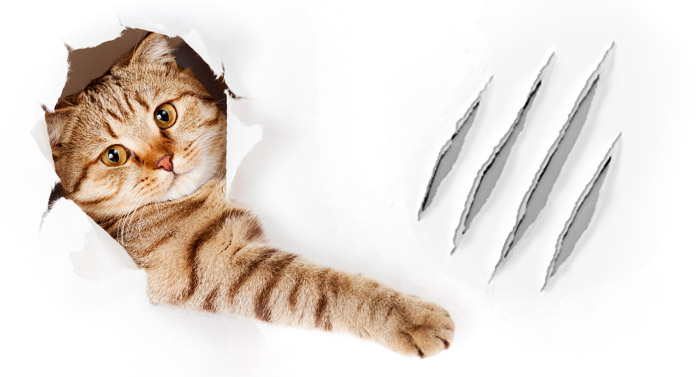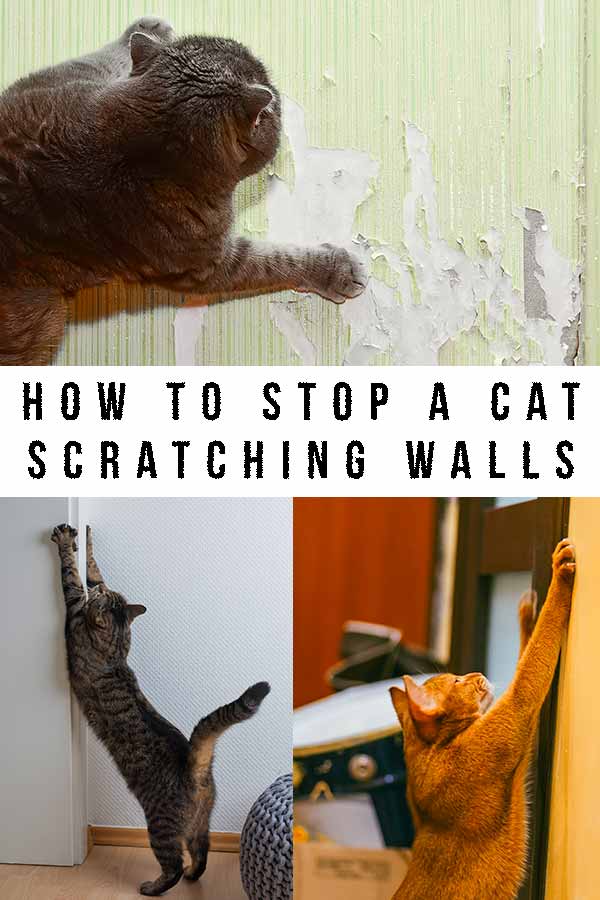
Cat owners wondering how to stop a cat scratching walls aren’t alone. This multifunctional behavior is common to lots of cats
How to Stop A Cat Scratching Walls
Scratching is a normal feline behaviour that usually starts from around 5 weeks of age.
There are several reasons why cats scratch.
Firstly, it’s important that they exercise the muscles and the claw-motion used in hunting and climbing.
Secondly, it helps to remove the worn outer claw husks (or sheaths), revealing nice sharp claws underneath.
Thirdly, it provides cats with a way of stretching out their bodies which can help relieve muscular tension.
And finally, but very importantly, scratching is used by cats as a way of marking their territory.
Scratching to mark territory
Cats have scent glands in-between the pads on the underside of their paws, which mix to produce a unique smell.
When they scrape their claws down or along a surface, the scent is deposited. The combination of the visual mark and the smell makes them feel more secure in their environment, and provides a strong message to other cats.
Thankfully, whilst we humans might not welcome the visual mark, at least we cannot smell the scent mark!
What Do Cats Scratch?
Cats choose a variety of surfaces for scratching – both indoors and outdoors, and vertical and horizontal, depending on their individual preferences.

The most common surfaces tend to be those that are stable enough to withstand the force applied by them as they scratch.
Clearly some of the most stable surfaces available are the walls of our homes. But usually only if they are covered with an attractive material such as textured wallpaper.
As well as walls, cats will use doorframes, window frames or bannisters made of soft wood such as pine.
Then there are the old favourites such as carpets and sofas.
Where Do Cats Scratch?
Given the choice, cats like to show-off their scratching prowess in front of us and/or other cats.
This is their way of showing territorial confidence: “this is my turf and don’t you forget it!”
So, a lovely big wall in a family or living room is likely to get the cat scratch treatment.
However, if you notice your cat scratching in lots of different locations around the house, in particular on walls around exit and entry points such as windows and doors, it could be that they are signalling a general sense of insecurity.
This could be due to the presence of more assertive cats either inside or out.
A cat might also scratch a wall or door as a way of trying to escape from a room in which he is confined.
This is usually accompanied by vocalisation designed to get our attention.
The Importance Of Scratching
Whether it’s walls, doors, carpets or sofas, scratching is a behaviour which is innate in all cats.
And if you don’t provide a suitable surface for this activity, you may well end up with ruined wallpaper, badly marked doors and furniture in tatters!
This is where scratching posts play an important role.
Scratching Posts
Scratching posts can come in all sorts of shapes and sizes.
There are small ones for kittens, tall multi-platform posts, wide barrel scratchers, as well as horizontal scratchers.
However, it’s not enough to buy just any old scratching post and put it somewhere in our homes where it blends in with the rest of the furniture.
We need to provide the right sort of scratching posts, in the right quantity, and put them in locations where our cats are likely to use them.
All this may take trial and error, and is also very much dependent on your budget and the space available.
What Type of Cat Scratching Post Should I Buy?
Before buying a scratching post for your cat, you may want to consider the following:
Get your kitten into good habits early by purchasing small sisal scratching posts for them to get their claws into!
As cats grow, so should the size of their scratcher. Whether they are individual vertical posts or tall multi-level cat trees, there should be at least one post that is long enough to allow your cat to scratch at full stretch.
Tall, modular cat activity centres allow cats to climb and scratch and provides a high place for them to rest and feel secure.
For the more anxious feline, you might like to choose one that includes a part-enclosed cave.
Safety First!
The post must be stable enough to withstand the strong pull from your cat’s claws.
If it moves around or even topples over, your cat may be put off using it for life!
For standalone scratchers, those shaped like a barrel provide a bit more stability. And for the ultimate in steadiness, tall sisal scratching posts are available that can be fixed to the wall.
These are particularly good for the wall scratchers of the cat world.
Scratching Posts Vs Panels
Although not particularly aesthetically pleasing, another idea for cats that scratch walls is to attach a dedicated scratching panel, at an appropriate height, on the applicable walls.
These can be a particularly good option if space is limited.
They are now commercially available, or you can even make your own using woodchip panels and covering them with either sisal twine or carpet.
Scratching Alternatively
Although you may have a cat that scratches the walls, in multi cat households there may be others that prefer to scratch horizontally.
This may be especially true of the senior citizens of the feline world, and for cats that have some form of disability.
You can cater for their needs by providing scratching mats, scratching boxes made from corrugated cardboard, or even coir mats.
Where Should I Put A Cat Scratching Post?
If you have room for a scratching post, where you put it is just as important as the type of post you provide.
It may suit you if the post is in a discreet corner, but it’s likely that your cat will have little inclination to use it there.
Instead, you might like to try placing the post in front of a window in a room that your cat particularly likes being in.
If it has a platform this will give him a wonderful view of the outside action.
Cats often stretch and scratch when they wake up too, so it’s a good idea to position a cat scratcher next to their favourite sleeping place as well.
How Many Indoor Scratching Posts Should I Get?
If practical, one cat scratching post/mat for each cat in your home, plus one more is the ideal number, and these should be placed in separate locations.
Introducing A New Scratching Post To Your Cat
Having gone to the trouble of purchasing a new post for your cat, you’d no doubt like him to be as enthusiastic possible and start using it the moment it’s taken out of the box!
So, you could be forgiven for going to get him and for rubbing his front paws against the post.
If you do this, it’s more likely that he’ll head for his current favourite surface, and scratch that instead!
To make the post as attractive as possible, it’s best to let him discover and explore it for himself.
You can aid this process by sprinkling loose catnip around the base of the post; some scratching posts even come already impregnated with catnip.
Sealing The Deal
Once your cat has approached the new post you might like to use a toy such as a piece of string attached to a feather or a fishing rod toy, and swish it around the post so that his claws catch in the material covering it.
This often triggers a scratching motion.
If it’s a tall post with multiple levels, you can encourage your cat to climb it by putting dry food on the top level.
How To Stop A Cat Scratching Walls – Summary
I can’t emphasize enough how important scratching is for our cats.
Scratching walls meets behavioral and communication needs which are built into all cats, and essential for their welfare.
But given dedicated and appropriate outlets to perform this behaviour, your walls and other furnishings should remain intact!
Does Your Cat Scratch The Walls?
Have you noticed patterns in their behavior which helped you understand why they do it?
Have you succeeded in stopping them doing damage?
Let us know in the comments box down below!
Clare Hemington DipCAPBT is a cat behaviorist and member of the COAPE Association of Pet Behaviorists and Trainers.
I just started renting this new beautiful home and my cat is already scratching the door frames!!! I can’t put up with this! I will have to get rid of him if he doesn’t stop scratching. I have multiple scratch boxes all over the house, I put the wall scratchers up on corners of doors but he just avoids those and will scratch the door frames without them. And he doesn’t touch scratching posts. I need desperate help, I love my cat but I can’t have him destroying my rental home. I looked into getting his nails capped but I can’t afford that every month! What do I do??